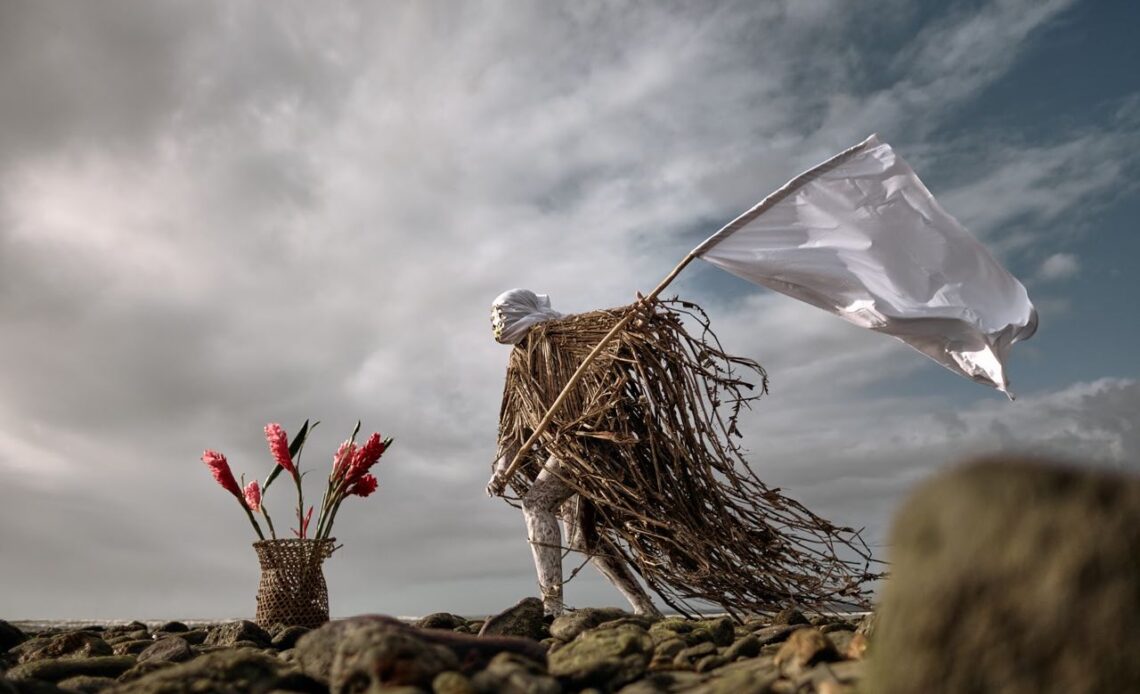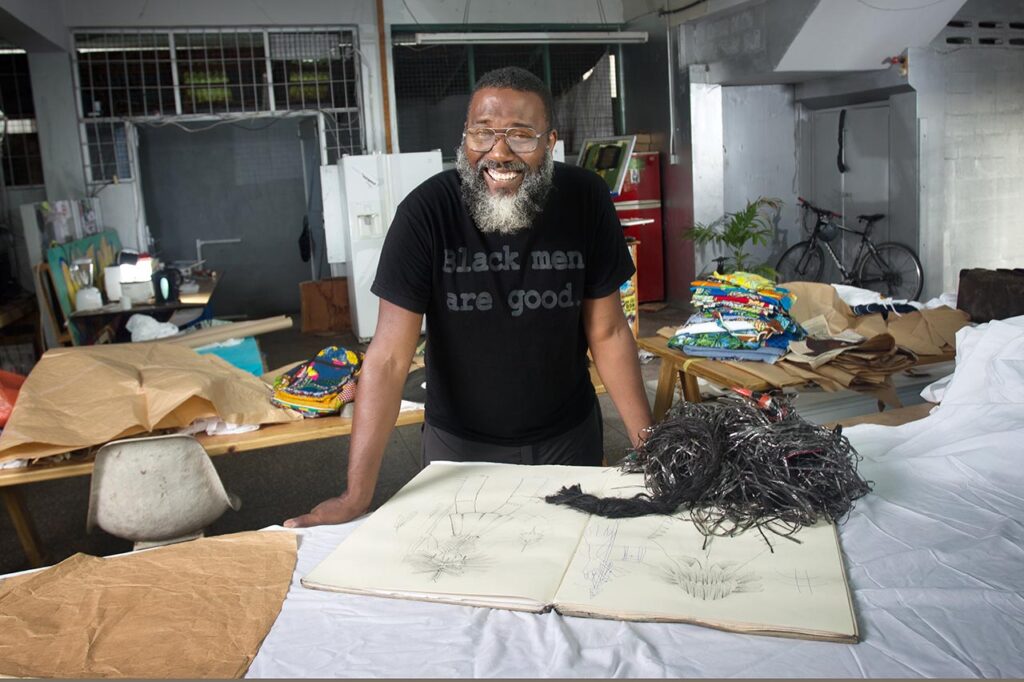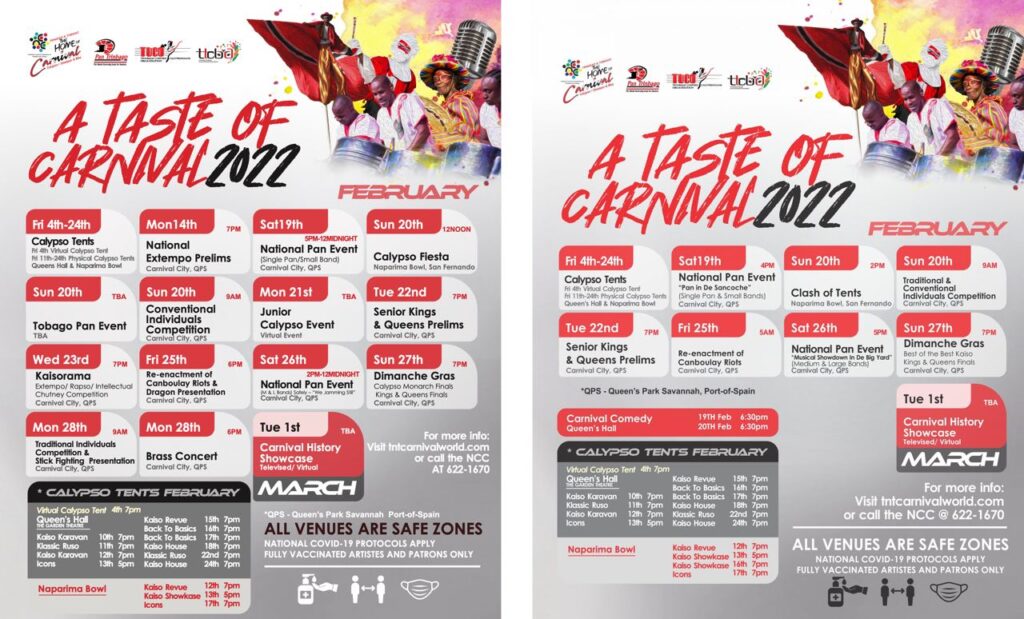
Above: Vulgar Fraction costume prototype. Photo by Jason Audain.
BitDepth#1343 for February 28, 2022.
The NCC’s A Taste of Carnival is a reflex action, a spastic twitch bereft of conscious action.
In this almost completely state-funded version of the festival, millions have been spent on temporary infrastructure with crumbs left for the creators who provide the fuel for Carnival’s conceptual engine.
Every item scheduled since February 10th, except for stickfighting, has been experiencing diminished public interest for most of the last two decades.
How many have actually paid to attend these events? Who wanted a pod outside of a soca concert?
I’ve come to think of Carnival as being more than a little like the famous photos that the photographer Sebastiao Salgado shot in 1986 of Brazil’s Serra Pelada gold mine.
In the photographs, which sell for tens of thousands today, hundreds of mud-covered workers scramble along slick slopes and up rickety ladders to haul sacks weighing as much as a sack of cement up the slippery slope of the vast hole.
What’s in the sacks? Nobody knows until they are emptied into pools of water and sifted for gold. Each sack earned its bearer 60 cents with a small bonus if gold was found.
There was no shortage of workers. At least 100,000 garimpieros worked the mine at its peak. Fights broke out regularly and at least 80 deaths were recorded (a gallery of Salgado’s images can be found here.).
In today’s Carnival, we are running out of miners.
As generations of Carnival’s creators die out, forgotten and ignored, the skills of sifting the festival’s creative gold disappear and new creators choose to work simpler mines.

Carnival didn’t become a festival because it was meant to be mined for profit, it rose to prominence through the drive and enthusiasm of individuals for a big idea.
Three of them in fact; exploring fantasy and mockery through costuming, telling stories that might never otherwise be told through song, and hammering music out of discarded steel drums.
Together, these parallel creative movements became one powerful thing that transcended its components.
Fashion designer Robert Young turned his small Carnival band Vulgar Fraction this year to the idea of returning that process to individuals.
The 2022 band, Mas Mourning – Becoming Wreaths, contemplates loss during the covid19 pandemic.
The project began with a collaboration with UWI’s DCFA arts students who are building costumes inspired by the prototypes produced for the band launch.
Players, Young, expects, will build their own (full interview).
“There are parts of the costume we will make,” Young said, “We will provide dried fig leaves if they require leaves, and we provide a fabric mask.”
“There are backpacks if you want to carry the costume high. Then you, as your own maker, have to engage with the material and see how you can use it.”
“Some costumes are just leaves, others are cut leaves stuck on fabric. It’s a deep design study in the material; we all know fig trees and how they look like someone standing outside in the dark.”
It’s all pretty far from receiving a finished costume in a neat box, and players are also expected to make contact with the band to discuss the loss they are commemorating.
Photographers are available to visit players at their homes to record the finished costume being worn.
Young doesn’t think much of the Government’s Taste of Carnival initiative.

“We didn’t have to rush for a taste,” Young said.
“We could have waited. It was a response to the idea that our Carnival could be lost. Yes, it could be lost if we keep pushing it away from the people.”
“We could have been supporting activities in the community that people could engage with.”
Making a change can often begin with one person and one idea.
We may never return to the explosive alchemy of the earliest Carnivals, but the creative capacity is there to translate the experiences of today into something new and equally relevant to modern society.
Salgado and his wife began remediating 17,000 acres of barren land in Brazil’s Atlantic Forest in 1998.
By 2013, Instituto Terra had restored forest conditions that were attracting wildlife and producing one million native seedlings per year for other reforestation projects.
Salgado’s pivotal early work at Serra Pelada examined what happens when you strip a resource down to bare rock. Then he committed to rebuilding a sustainable resource by planting one tree at a time.


